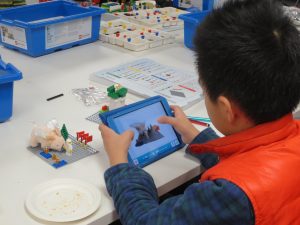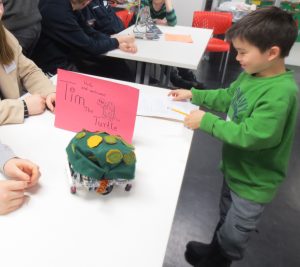by Barbara Bratzel
The end of January and beginning of February was a lively time in the CEEO workshop room: we hosted two international groups of students.
The last week of January, seven students from China, ages nine to eleven, plus two of their teachers, spent four days with us. The students were winners of StoryGames China, a LEGO story-telling competition. The CEEO helped to develop the concept for the contest, which asked students to use LEGO StoryStarter and StoryVisualizer to imagine a day in the life of astronauts in the future. Two members of the CEEO, Aaron Johnson and Sara Willner-Giwerc, traveled to Shanghai to help judge the competition.
The children’s four days at the CEEO were packed with story telling, art, and engineering. At the start, perhaps daunted by the unfamiliar surroundings and language, the children were quietly serious. However, they soon loosened up. Since the children already knew the StoryVisualizer software, Barbara Bratzel and Dan Luo, who ran the workshop, showed them how to insert photos of their faces into LEGO scenes. The students discovered that when you see your head on a LEGO minifigure body, it’s hard to remain solemn. The students used the software to create autobiographical comics, realistic or fictional. Many of the children envisioned themselves as astronauts.
In the days that followed, the children explored MINDTORMS EV3 and littleBits. They built ball-throwing robots and engineered solutions to problems in Aesop’s fables. One of the highlights of the week was collaboration day, when a group of American students joined the Chinese students. The Chinese students showed the American students their winning StoryGames presentations—in English! Then, both groups joined together to create robotic artists for Dr. E’s MINDSTORMS Challenge—and to cover the workshop room with paint.
The second week brought twenty-five high school students and two teachers from Denmark for a two-day EV3 MINDSTORMS workshop—and also brought a snowstorm. The Danish students were amused by the snow day granted to most of the Boston-area students. Snow days, it turns out, are unheard of in Denmark. In their workshop, the students built mechanical structures such as four-bar linkages and reciprocating legs. They learned a variety of methods for using sensor output to control the flow of a program. They explored various methods of feedback control, including using data logging to see what happened when they increased the gain in a proportional controller. As a culmination, the students applied what they had learned, along with considerable ingenuity, to create robotic pets that would respond to people. In addition to dogs Flappy, Doge, and Maggie, the pets included Tim the turtle, Kitty the cat, Forrest the fish, Parker the spider, and Kurt the ostrich. To put their pets to the test, we invited some special guests—a group of 4-8 year olds, who interacted with the pets and quizzed their creators before rendering verdicts on the pets’ lovability and play potential. Much as they wanted to, the young testers were not allowed to take any of the pets home with them.


